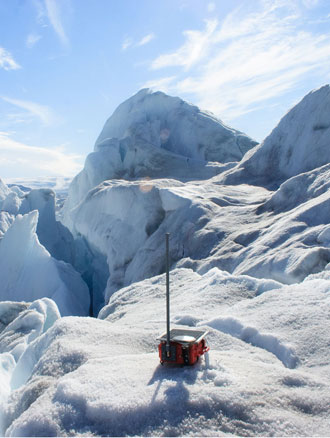June
Backward-moving glacier helps scientists explain glacial earthquakes

New insight into glacier behaviour will improve our ability to predict future sea-level rise in a warming climate.
The relentless flow of a glacier may seem unstoppable, but now a team of UK and US researchers have shown that during some calving events – when an iceberg breaks off into the ocean – the glacier moves rapidly backward and downward, causing the characteristic glacial earthquakes which until now have been poorly understood.
Published in Science Express, this new insight into glacier behaviour should enable scientists to measure glacier calving remotely and will improve the reliability of models that predict future sea-level rise in a warming climate. Understanding this glacier behaviour and the associated glacial earthquakes is a crucial step towards measuring calving events and their contribution to sea-level change remotely. This tool has the potential to provide unprecedented, global and near real-time estimates of iceberg loss from the ice sheet.
The Greenland Ice Sheet is an important contributor to global sea-level and nearly half of the ice sheet’s annual mass loss occurs through the calving of icebergs to the ocean. Glacial earthquakes have increased seven-fold in the last two decades and have been migrating north suggesting an increase in rates of mass loss from the ice sheet through calving.
Helheim Glacier is one of the largest glaciers in southeast Greenland and at 6 km wide and over 200 km long it can flow as fast as 30 m per day. Icebergs calving from Helheim Glacier can be very large and have been measured up to 4 km across and with a volume of about 1.25 km3.
During the summer of 2013, researchers from Swansea, Newcastle and Sheffield Universities installed a robust wireless network of Global Positioning System (GPS) devices on the chaotic surface of Helheim in order to measure velocity and displacement of the glacier surface. With US collaborators from Columbia University’s Lamont-Doherty Earth Observatory, the University of Michigan and Emory University, earthquake data from the Global Seismographic Network and scaled-down models in water tanks were used to explain the unexpected movements of the glacier in the minutes surrounding the calving events.
Dr Stuart Edwards, lead Scientist for Newcastle University’s team based in the School of Civil Engineering and Geosciences, said: “When we saw the fit of our GPS observations to the scaled laboratory data during “iceberg” capsize we knew we were on to something rather special. Our network of GPS sensors delivered everything we could have hoped for.”
Professor Tavi Murray, lead author of the study based at Swansea University, added, “We were really surprised to see the glacier flowing backwards in our GPS data. The motion happens every time a large iceberg is calved and a glacial earthquake is produced. A theoretical model for the earthquakes and the laboratory experiments have allowed us to explain the backwards and downwards movement.”
This research was supported by the UK Natural Environment Research Council, the US National Science Foundation and the Climate Change Consortium of Wales and Thales UK.
Source information: Reverse glacier motion during iceberg calving and the cause of glacial earthquakes. T. Murray, M. Nettles, N. Selmes, L. M. Cathles, J. C. Burton, T. D. James, S. Edwards, I. Martin, T. O’Farrell, R. Aspey, I. Rutt, and T. Baugé. Science Express June 2015
published on: 25 June 2015
